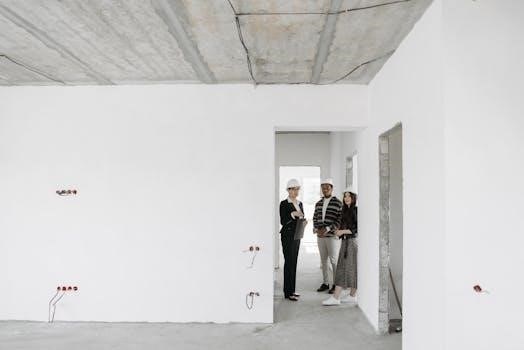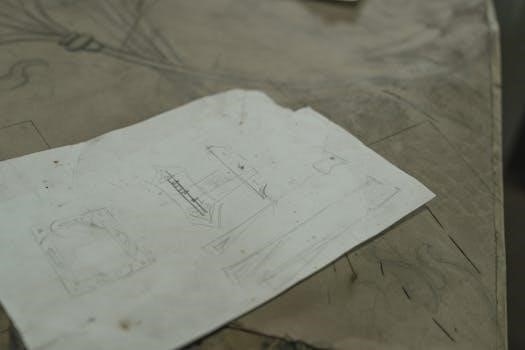Blueprint Steam Engine Plans PDF⁚ A Comprehensive Guide

Embark on a fascinating journey into the world of steam power with our comprehensive guide to blueprint steam engine plans in PDF format. This resource serves as your starting point for exploring, understanding, and ultimately building your very own miniature steam marvel.
Steam engine blueprints are technical drawings that serve as a visual language for engineers and hobbyists alike, providing detailed instructions for constructing a steam engine. These blueprints are essential for understanding the engine’s design, dimensions, and the relationships between its various components.
Historically, steam engine blueprints were meticulously hand-drawn, often on large sheets of paper. Today, many blueprints are created and distributed digitally, often in PDF format, making them easily accessible to a global audience.
A good steam engine blueprint will show every part of the engine, the dimensions of each part, the materials needed, and how the parts fit together. This precise detailing is necessary to make sure the engine works properly and safely.
These blueprints are not just for professional engineers. With a bit of patience and practice, anyone can learn to read and understand them. Whether you’re a seasoned machinist or a curious beginner, steam engine blueprints offer a gateway to a rewarding and educational hobby.
The best blueprints are well-written, well-organized, and profusely illustrated. They may also include step-by-step instructions and helpful tips.
Understanding PDF Plans
The PDF (Portable Document Format) has become a standard for distributing steam engine plans due to its accessibility and versatility. PDF plans offer several advantages over traditional paper blueprints. They can be easily shared, viewed on various devices, and printed as needed.
When working with PDF steam engine plans, it’s essential to understand how to navigate and interpret them effectively. Most PDF viewers allow you to zoom in for detailed inspection of specific components and dimensions. Look for features like layers, which may allow you to isolate certain parts of the drawing for clarity.
Pay close attention to the scale of the drawing. PDF plans often include a scale bar, which allows you to accurately measure distances on the blueprint and translate them to real-world dimensions.

Also, make sure you have the correct software to open and view the PDF files; Adobe Acrobat Reader is a popular choice, but there are many other free and paid PDF viewers available.
Finally, remember that digital plans are susceptible to corruption or damage. Always keep a backup copy of your PDF plans to prevent data loss.
Types of Steam Engine Plans Available
The world of steam engine plans is vast and diverse, offering a multitude of designs to suit various skill levels and interests. From simple oscillating engines perfect for beginners to intricate compound engines for experienced machinists, there’s a plan for everyone.
Oscillating Engines⁚ These are among the simplest steam engine designs, characterized by a pivoting cylinder that directs steam flow. Their simplicity makes them an excellent starting point for novice builders.
Single-Acting Engines⁚ In this type, steam acts on only one side of the piston, providing power during a single stroke. They are commonly found in smaller models.
Double-Acting Engines⁚ Steam acts on both sides of the piston, delivering power during both strokes, resulting in increased efficiency and power output.
Stationary Engines⁚ These engines are designed to remain in a fixed location, typically used for powering machinery in factories or workshops.
Locomotive Engines⁚ Replicating the power of railway legends, these plans enable the construction of miniature steam locomotives.
Marine Engines⁚ Designed for boats and ships, these engines come in various configurations, from simple single-cylinder designs to complex multi-cylinder arrangements.
Free vs. Paid Steam Engine Plans
When embarking on your steam engine building journey, one of the first decisions you’ll face is whether to opt for free or paid plans. Both options have their own advantages and disadvantages, and the best choice depends on your experience, budget, and desired level of detail.
Free Plans⁚ These plans are readily available online, often contributed by hobbyists and enthusiasts. They can be a great starting point for beginners or those on a tight budget. However, free plans may lack detail, accuracy, or comprehensive instructions, potentially leading to challenges during the build process. Support from the original designer may also be limited.
Paid Plans⁚ Paid plans typically offer a higher level of detail, accuracy, and completeness. They often include comprehensive instructions, detailed drawings, and material lists. Furthermore, paid plans may come with support from the designer, providing assistance with troubleshooting and modifications. While paid plans require an initial investment, they can save time and frustration in the long run, particularly for complex projects.
Ultimately, the choice between free and paid plans depends on your individual needs and preferences. Consider your skill level, budget, and the complexity of the project before making a decision.
Essential Components and Materials
Constructing a steam engine, regardless of its design, necessitates careful selection of components and materials. The choice of materials directly impacts the engine’s performance, durability, and overall lifespan. Understanding the purpose of each component is crucial for a successful build.
Key Components⁚ The core of a steam engine consists of several essential parts. The cylinder, where the steam expands and drives the piston, is paramount. The piston, moving linearly within the cylinder, converts steam pressure into mechanical energy. A valve system controls the steam flow into and out of the cylinder. The crankshaft translates the linear motion of the piston into rotary motion. Finally, connecting rods link the piston to the crankshaft.
Material Selection⁚ Common materials include brass, steel, and cast iron. Brass, known for its machinability and corrosion resistance, is often used for cylinders and valve components. Steel, offering high strength and durability, is ideal for crankshafts, connecting rods, and other stressed parts. Cast iron, with its excellent damping properties, can be used for the engine frame and other structural components. The specific materials will vary depending on the engine’s design and operating conditions.
Tools Required for Building a Steam Engine

Embarking on the construction of a steam engine demands a well-equipped workshop. The complexity of the project necessitates a range of tools for machining, fitting, and assembling the various components. Having the right tools not only ensures precision but also enhances safety and efficiency.
Essential Machining Tools⁚ A lathe is indispensable for creating cylindrical parts, such as pistons, cylinders, and shafts. A milling machine is crucial for shaping flat surfaces, creating slots, and machining complex geometries. A drill press is needed for drilling accurate holes. A grinder is essential for sharpening tools and finishing surfaces. Measuring tools like calipers, micrometers, and dial indicators are vital for ensuring dimensional accuracy.
Assembly and Hand Tools⁚ Wrenches, screwdrivers, and pliers are necessary for assembling the engine. Files and sandpaper are used for deburring and smoothing surfaces. A soldering iron is needed for joining brass or copper parts. A tap and die set is essential for creating threads. Finally, safety equipment, including safety glasses, gloves, and a dust mask, is crucial for protecting yourself during the building process.
Reading and Interpreting Blueprints
Successfully building a steam engine from PDF blueprints hinges on your ability to accurately read and interpret the technical drawings. Blueprints are the language of engineering, conveying precise information about the dimensions, materials, and assembly of each component.
Understanding Drawing Conventions⁚ Familiarize yourself with standard drafting symbols, line types, and dimensioning techniques. Different line weights indicate visible edges, hidden features, and center lines. Understand the difference between orthographic projections (top, front, side views) and isometric views. Pay close attention to tolerances, which specify the acceptable range of variation for each dimension.
Deciphering Dimensions and Notes⁚ Blueprints use various dimensioning methods, including linear dimensions, diameters, radii, and angles. Ensure you understand the units of measurement (e.g., inches, millimeters). Read all notes carefully, as they often provide crucial information about materials, finishes, or special instructions. Learn to identify different types of threads and their specifications. With practice, you will develop the skill to translate these two-dimensional drawings into a clear mental picture of the three-dimensional engine.
Step-by-Step Construction Process
The construction of a steam engine from PDF blueprints is a methodical process that demands patience and precision. Before starting, carefully review the entire set of plans to gain a comprehensive understanding of the project.
Phase 1⁚ Component Fabrication⁚ Begin by manufacturing each component according to the dimensions and specifications outlined in the blueprints. Start with the simplest parts and progressively move towards the more complex ones. Use appropriate machining techniques, such as turning, milling, and drilling, to achieve the desired accuracy.
Phase 2⁚ Assembly⁚ Once all the components are fabricated, begin the assembly process. Follow the sequence outlined in the plans, ensuring that each part fits correctly and functions as intended. Use appropriate fasteners, such as screws, bolts, and pins, to secure the components together. Pay close attention to alignment and clearances to ensure smooth operation.
Phase 3⁚ Testing and Adjustment⁚ After assembly, thoroughly test the engine with compressed air or steam to identify any leaks or malfunctions. Make necessary adjustments to optimize performance and ensure safe operation. Lubricate all moving parts to reduce friction and prevent wear. Congratulations, you have completed the construction!
Safety Precautions and Considerations
Constructing a steam engine, even a model, necessitates stringent adherence to safety protocols. Prioritize your well-being throughout every phase of the project. When machining parts, always wear appropriate eye protection to shield against flying debris. Securely clamp workpieces to prevent unexpected movement during machining operations.
Exercise caution when handling sharp tools and machinery. Be mindful of pinch points and moving parts to avoid injuries. When working with potentially hazardous materials, such as solvents or lubricants, ensure adequate ventilation and wear appropriate protective gear.
Before operating the engine, thoroughly inspect all components for any signs of damage or wear. Ensure that all connections are secure and that the engine is properly grounded. When testing the engine with compressed air or steam, start with low pressures and gradually increase the pressure while monitoring for leaks or malfunctions.
Never operate the engine in an enclosed space, as this could lead to a buildup of dangerous gases. Keep a fire extinguisher readily available in case of emergency. Above all, exercise caution and common sense to ensure a safe and enjoyable building experience.
Troubleshooting Common Issues
Even with meticulous planning and execution, issues can arise during the construction and operation of a steam engine. One common problem is steam leakage, which can occur at joints, seals, or threaded connections. To address leaks, carefully inspect the affected area and tighten any loose connections. If necessary, replace worn or damaged seals with new ones;
Another potential issue is binding or friction in moving parts, which can impede the engine’s performance. This can be caused by misalignment, tight tolerances, or inadequate lubrication. Check for any obstructions or burrs that may be causing the binding. Ensure that all moving parts are properly lubricated with a suitable oil or grease.
If the engine fails to start or runs erratically, the problem may be related to the valve timing. Verify that the valves are opening and closing at the correct times. Adjust the valve timing as needed to optimize engine performance. Also, check the steam supply and ensure that it is adequate to power the engine.

By systematically troubleshooting these common issues, you can effectively diagnose and resolve any problems that may arise, ensuring the successful operation of your steam engine.
Resources for Steam Engine Enthusiasts
The world of steam engine building is rich with resources for enthusiasts of all levels. Online forums and communities provide a platform for sharing knowledge, asking questions, and connecting with fellow builders. Websites dedicated to model engineering often feature articles, tutorials, and project logs that offer valuable insights and inspiration.
For those seeking detailed plans and technical information, specialized publications and books are available. These resources often include comprehensive drawings, step-by-step instructions, and helpful tips for building various types of steam engines. Additionally, many museums and historical societies maintain archives of steam engine plans and related materials.
Local model engineering clubs and societies can provide opportunities for hands-on learning, collaboration, and mentorship. These groups often organize workshops, demonstrations, and exhibitions where members can showcase their projects and learn from experienced builders.
Don’t underestimate the value of online video platforms like YouTube. Many creators share their steam engine builds, offering visual guides and practical advice. Exploring these diverse resources will undoubtedly enrich your steam engine journey.
Advanced Steam Engine Designs
For seasoned builders seeking a challenge, advanced steam engine designs offer a captivating realm of complexity and innovation. These designs often incorporate intricate features, such as compound cylinders, sophisticated valve gear mechanisms, and condensers, pushing the boundaries of steam engine performance and efficiency.
Advanced plans may involve more intricate machining, demanding precision and expertise in using various tools and techniques. Builders might explore unconventional engine configurations, such as rotary engines or uniflow engines, each presenting unique engineering challenges and rewards.
Delving into advanced designs requires a deep understanding of thermodynamics, fluid dynamics, and materials science. Builders may need to perform calculations and simulations to optimize engine performance and ensure structural integrity. Experimentation and iterative design become crucial aspects of the building process.
The pursuit of advanced steam engine designs not only hones technical skills but also fosters creativity and problem-solving abilities. It’s a journey of continuous learning and refinement, where builders can push the limits of their capabilities and create truly exceptional steam-powered creations.
Embarking on the journey of building your own steam engine from blueprints is a rewarding endeavor that combines technical skill, creativity, and a deep appreciation for engineering history. The process, from deciphering intricate PDF plans to meticulously machining and assembling each component, offers a unique sense of accomplishment.
The joy of building extends beyond the mere construction of a machine. It’s about understanding the principles of steam power, mastering various machining techniques, and problem-solving challenges along the way. The satisfaction of seeing your creation come to life, powered by the very force of steam, is unparalleled.
Whether you’re a seasoned machinist or a curious beginner, the world of steam engine building has something to offer. The availability of detailed PDF plans makes the process accessible, allowing you to learn and grow with each project. The steam engine community provides a supportive network for sharing knowledge, troubleshooting issues, and celebrating successes.
So, embrace the challenge, delve into the blueprints, and experience the joy of building your own steam engine. It’s a journey that will ignite your passion for engineering and leave you with a lasting sense of pride and accomplishment.